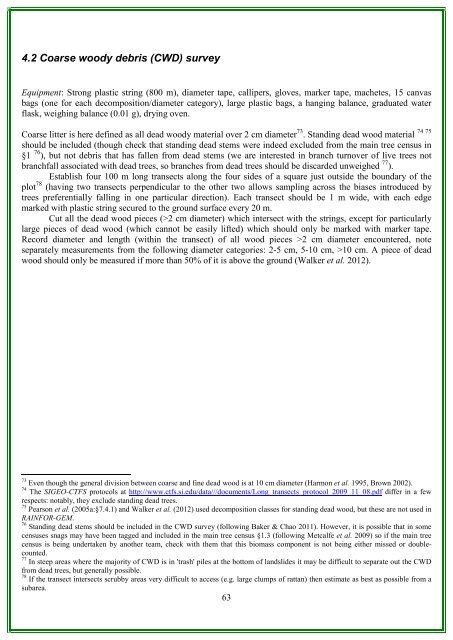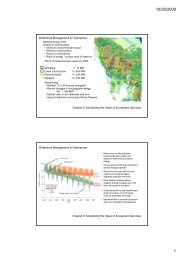RAINFOR GEM Intensive Plots Manual (pdf) - University of Oxford
RAINFOR GEM Intensive Plots Manual (pdf) - University of Oxford
RAINFOR GEM Intensive Plots Manual (pdf) - University of Oxford
- No tags were found...
Create successful ePaper yourself
Turn your PDF publications into a flip-book with our unique Google optimized e-Paper software.
4.2 Coarse woody debris (CWD) surveyEquipment: Strong plastic string (800 m), diameter tape, callipers, gloves, marker tape, machetes, 15 canvasbags (one for each decomposition/diameter category), large plastic bags, a hanging balance, graduated waterflask, weighing balance (0.01 g), drying oven.Coarse litter is here defined as all dead woody material over 2 cm diameter 73 . Standing dead wood materialshould be included (though check that standing dead stems were indeed excluded from the main tree census in§1 76 ), but not debris that has fallen from dead stems (we are interested in branch turnover <strong>of</strong> live trees notbranchfall associated with dead trees, so branches from dead trees should be discarded unweighed 77 ).Establish four 100 m long transects along the four sides <strong>of</strong> a square just outside the boundary <strong>of</strong> theplot 78 (having two transects perpendicular to the other two allows sampling across the biases introduced bytrees preferentially falling in one particular direction). Each transect should be 1 m wide, with each edgemarked with plastic string secured to the ground surface every 20 m.Cut all the dead wood pieces (>2 cm diameter) which intersect with the strings, except for particularlylarge pieces <strong>of</strong> dead wood (which cannot be easily lifted) which should only be marked with marker tape.Record diameter and length (within the transect) <strong>of</strong> all wood pieces >2 cm diameter encountered, noteseparately measurements from the following diameter categories: 2-5 cm, 5-10 cm, >10 cm. A piece <strong>of</strong> deadwood should only be measured if more than 50% <strong>of</strong> it is above the ground (Walker et al. 2012).74 7573 Even though the general division between coarse and fine dead wood is at 10 cm diameter (Harmon et al. 1995, Brown 2002).74 The SIGEO-CTFS protocols at http://www.ctfs.si.edu/data///documents/Long_transects_protocol_2009_11_08.<strong>pdf</strong> differ in a fewrespects: notably, they exclude standing dead trees.75 Pearson et al. (2005a:§7.4.1) and Walker et al. (2012) used decomposition classes for standing dead wood, but these are not used in<strong>RAINFOR</strong>-<strong>GEM</strong>.76 Standing dead stems should be included in the CWD survey (following Baker & Chao 2011). However, it is possible that in somecensuses snags may have been tagged and included in the main tree census §1.3 (following Metcalfe et al. 2009) so if the main treecensus is being undertaken by another team, check with them that this biomass component is not being either missed or doublecounted.77 In steep areas where the majority <strong>of</strong> CWD is in 'trash' piles at the bottom <strong>of</strong> landslides it may be difficult to separate out the CWDfrom dead trees, but generally possible.78 If the transect intersects scrubby areas very difficult to access (e.g. large clumps <strong>of</strong> rattan) then estimate as best as possible from asubarea.63





